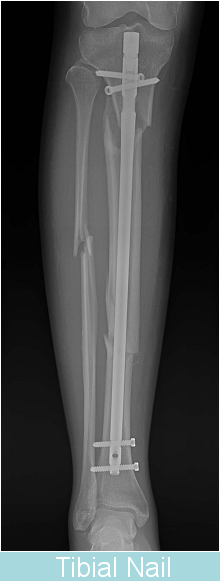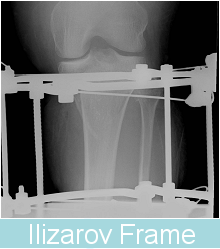Orthopaedic Conditions & Treatments
 Fractures are the same as broken bones and Mr McAndrew will treat all fractures of the lower limb and some upper limb fractures either with an operation or where appropriate using non-operative methods such as plasters or splints.
Fractures are the same as broken bones and Mr McAndrew will treat all fractures of the lower limb and some upper limb fractures either with an operation or where appropriate using non-operative methods such as plasters or splints.
For fractures of the hand and wrist, please see Mr Rahimtoola's website. (Visit Site)
Soft tissue limb injury
Soft tissue injuries commonly include muscles, ligaments and tendons especially the Achilles tendon. There are many other ligaments and tendons that can be injured especially around the knee and ankle.
Sports injury
Most sport injuries involve the limbs and are either fractures or soft tissue injuries.
Knee arthroscopy
Some conditions of the knee such as meniscal or cartilage injuries are amenable to key hole surgery. This is performed as a day case procedure.
High tibial osteotomy for early knee arthritis
In some cases early arthritis may affect only part of the knee joint and can be secondary to abnormal alignment of the bone. This can be treated by breaking the bone in a controlled manner and fixing the bone in a more anatomical position. This is intended to prevent the arthritis from progressing.
Bunion surgery
Bunions can be secondary to abnormal alignment of the first metatarsal or arthritis of the big toe joint. There are many ways to treat this including injections, shaving away excess bone, fusion of the joint and correction of the alignment of the bone. Most of these procedures are done as a day case and do not need plaster fixation.
Toe deformity correction
Some toes can develop clawing and this can be corrected by fusing the joints and holding the corrected position with a temporary wire for three to four weeks. Most of these are treated as day cases.
Morton's Neuroma
This is a painful lesion of the nerve that supplies the skin in the spaces between the second and third; third and fourth and fourth and fifth toes. After diagnosis it can be treated by either an injection or surgical removal in the day case unit.
Non-union and mal-union of fractures
 Unfortunately some fractures do not heal and can cause pain and delayed return to normal activities. Each case is different and there are many ways to treat them including a pulsed ultrasound device, plates and screws, nails (large pins) in the centre of the bone and even external fixators that act as a cage (Ilizarov fixator) to keep the bones held tightly so that they heal.
Unfortunately some fractures do not heal and can cause pain and delayed return to normal activities. Each case is different and there are many ways to treat them including a pulsed ultrasound device, plates and screws, nails (large pins) in the centre of the bone and even external fixators that act as a cage (Ilizarov fixator) to keep the bones held tightly so that they heal.
All of these methods of treatment are offered and may require more than one consultation to decide the most appropriate treatment. Many patients will wish to consider the options rather than make an instant decision and this is positively encouraged, because these are not simple procedures and may have complications with long lasting effects.
Mal-union of fractures and deformity correction in the lower limb
As well as not healing, bones can heal in an abnormal position with shortening or angular deformities. This can cause persistent pain or even arthritis in the joints attached to the bone. There are many ways of treating this problem. The methods are similar to treating a non-union, however if there is shortening or the correction can not be achieved in one session an Ilizarov fixator is used to correct it gradually. This can be a long procedure taking many months to achieve the final result.
